- Chitin
-
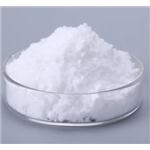
- $100.00 / 1kg
-
2024-04-24
- CAS:1398-61-4
- Min. Order: 1kg
- Purity: 99%
- Supply Ability: 20Tons
- Chitin
-
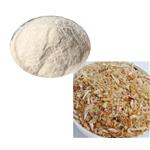
- $0.00 / 1KG
-
2024-04-23
- CAS:1398-61-4
- Min. Order: 1KG
- Purity: ≥98% HPLC
- Supply Ability: 1000KG
- Chitin
-
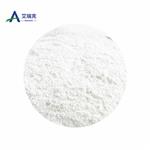
- $0.00 / 1Kg
-
2024-04-07
- CAS:1398-61-4
- Min. Order: 1Kg
- Purity: 99.9%
- Supply Ability: 200tons
Related articles - The application of chitin?
- Chitin is the second most abundant polysaccharide available in nature, after cellulose. Composed of N-acetyl-D-glucosamine and....
- Oct 8,2021
|
| | Chitin Chemical Properties |
| Melting point | >300°C (dec.) | | Boiling point | 737.18°C (rough estimate) | | density | 1.3744 (rough estimate) | | refractive index | 1.6000 (estimate) | | storage temp. | Room Temp | | solubility | dilute aqueous acid (pH <6.5).: soluble | | form | purified powder | | color | White | | Water Solubility | insoluble | | Merck | 14,2065 | | Stability: | Stable. Incompatible with strong oxidizing agents. | | LogP | -2.640 (est) | | EPA Substance Registry System | Chitin (1398-61-4) |
| | Chitin Usage And Synthesis |
| Description | Chitin is a naturally occurring polysaccharide found in the shells of living organisms such as crabs, lobsters, tortoise, shrimps, and insects or it can be generated via fungal fermentation processes. And chitosan is a unique biobased polymer that is a derivative of chitin and forms the exoskeleton of arthropods. It is obtained by partial deacetylation of chitin using a chemical method or by enzymatic hydrolysis. In general, chitin with a degree of deacetylation of 70% or above is considered to be chitosan. | | Chemical structure | Chitin is a naturally occurring polymer consisting of 2-acetamido-2- deoxy-D-glucose via a β(1-4) linkage. Three forms of chitin are available, namely α-, β-, and γ-chitin, however, the structure of α-chitin has been investigated more extensively than that of either the β- or γ- form. Very few studies have been carried out on γ-chitin because γ-chitin may be a distorted version of either α- or β-chitin.
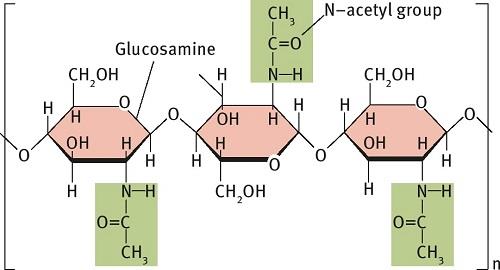
Its structure is similar to cellulose but with 2-acetamido-2-deoxy-β-D-glucose (NAG) monomer units. Chitin has limited applications because of its acetyl groups, but through the deacetylation process chitin is converted into chitosan. During the deacetylation process, the acetyl group present in chitin is converted into hydroxyl (-OH) and amino (-NH2) groups in the chitosan. The modification of the reactive functional groups present in chitosan opens the possibility of broad application in many fields. | | Source | Chitin is usually isolated from the exoskeletons of arthropods’ chitin-based tissue (30%-40% protein, 30%-50% calcium carbonate, and 20%-30% chitin), such as crustaceans, mollusks, insects, and certain fungi. It is a biological nanocomposite material strictly hierarchically organized which reveals various structural levels. At the molecular level is the polysaccharide chitin itself. The next structural level is the arrangement of c. 18-25 of such molecules in the form of narrow and long crystalline units, which are wrapped by proteins, forming nanofibrils of about 2-5 nm diameter and about 300 nm length. The next step in the scale consists of the clustering of some of these nanofibrils into long chitin-protein fibers of about 50-300 nm diameter.
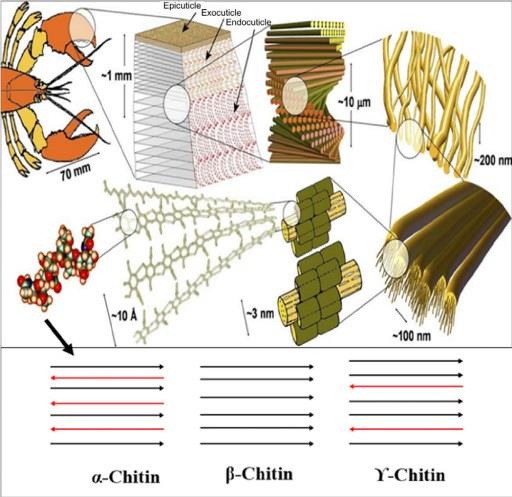
Chitin is mainly occurs in three different polymeric α-, β-, and γ-forms. The chains are arranged in stacks or sheets in α-chitin and adjacent sheets along the c-axis have the same direction in a parallel arrangement. The α-chitin occurs in the exoskeletons of crustaceans (e.g., crabs, lobsters, and prawns). In the case of β-chitin, the adjacent sheets along the c-axis present in opposite directions in an antiparallel arrangement and it can be found in squid pen, certain diatoms, and vestimentiferans (a class of deep-sea animal). However every third sheet is in the opposite direction to the preceding sheets in γ-chitin. It mainly exists in fungi and yeast. | | applications | Chitin and its derivative chitosan are natural biopolymers which are extracted from crabs, prawns, and shrimps. Chitin consists of β-(1,4)- linked 2-acetamido-2 deoxy-β-D-glucose which is insoluble in water and hydrophobic in nature.
Chitin is a natural biopolymer, which is biocompatible and biodegradable and useful in many applications like biomedical, electronics, photography, and textiles. The main advantages of chitin and its derivates are the low cost and easily availability. The chitin-based composites like chitin beads, chitin nanofibers, and chitin hydrogels are used in drug delivery and tissue engineering applications. In recent times, chitin and its derivates have gained much importance in the field of electronic applications as sensors and energy storage applications. Chitin nanofiber papers are being used as flexible green electronics in solar cells and organic light-emitting diodes. Aksoy et al. prepared low-cost chitin derivatives with high conductivity, for the construction of Schottky diodes, which are useful for photoelectrical applications. Schauer et al. reported a variation of the piezoelectric effect of the chitin electrospun nanofibers. | | Preparation | Chitin (C8H13O5N)n, is derived from the Greek word “chiton,” meaning a coat of mail. It is a natural polysaccharide of β-(1-4)-N-acetyl-D-glucosamine monomers, first identified by the chemist Henri Braconnot in 1811.
A suspension of chitin crystallite particles was first prepared by Marchessault et al. in 1959. In this method, 2.5 N hydrochloric acid solution was used to treat purified chitin under reflux for 1 h. After the reflux, the excess acid was separated by a decantation process and then distilled water was added to obtain the suspension. It was observed from their method that the acid-hydrolyzed chitin spontaneously dispersed into rod-like particles that could be concentrated to a liquid crystalline phase and self-assembled to a cholesteric liquid crystalline phase above a certain concentration. Though chitins are present within numerous taxonomic groups, on the commercial scale they are usually extracted from marine crustaceans, mainly because a large amount of waste is available as a by-product of food processing. | | Description | Chitin is the most abundant natural amino polysaccharide. It has a similar annual yield as cellulose. Chitin is a kind of highly valuable material in biomedical applications because of its high biocompatibility, biodegradability and non-toxicity as well as its antimicrobial activity and low immunogenicity. It can be easily processed into gels, membrane, nanofibers, beads, nanoparticle, scaffold and sponges, enables its wide applications. In the tissue engineering, it can be used for manufacturing polymer scaffold to satisfy the demands of repairing, replacing, maintaining, or enhancing the function of a particular tissue or organ. In wound dressing, chitin can be used as antimicrobial reagent. In the field of drug delivery, the water-soluble carboxymethyl chitin (CMC) nanoparticle can be used as an effective carrier in drug delivery. | | Chemical Properties | Chitin is a colorless, crystalline or amorphous powder that is insoluble in water, organic solvents, dilute acids, and alkalis. It dissolves in concentrated mineral acids with simultaneous degradation of the polymer. Although chitosan is insoluble in water, it does dissolve in aqueous organic acids, for example, acetic and formic acids, as well as inorganic acids. Chitin and chitosan preparation can vary due to the source, with compositional differences. Similarly, the physicochemical characteristics of chitin and chitosan differ between crustacean species and preparation methods. Several studies have clearly demonstrated the specific characteristics of these products. The Mw and degree of deacetylation (DD) vary with process conditions. The physicochemical characteristics of chitin and chitosan influence their functional properties. Mw and DD vary with process conditions or different extraction methods. Chitosan's application depends on physical, biological, and chemical properties and chitosan depends on two parameters, such as DD and Mw. | | Uses | chitin (chitine) is a moisture retainer and film-forming agent. This is a naturally occurring polysaccharide found in the shells of crustaceans, such as shrimp and crab, as well as in some fungi and algae. It is also a naturally occuring fibre found in the shells of shellfish. Used for the analysis of chitinase. lysozyme substrate. | | Application | Chitin, a β(1,4) polymer chain of N-acetyl-D glucosamine, is used as a substrate to identify, differentiate and characterize chitinase(s) and chitin deacetylase(s). Chitin may be used as a viscosity/thickening agent or binder. | | Definition | ChEBI: Chitin is a polysaccharide comprisingchains of N-acetyl-d-glucosamine,a derivative of glucose. Chitin isstructurally very similar to celluloseand serves to strengthen the supportingstructures of various invertebrates. It is the second most abundant biopolymer on earth, found especially in insects and fungi. | | Agricultural Uses | Chitin is a polysaccharidec omprising chains of N-acetyl- D-glucosamine, a derivative of glucose, linked byβ-1,4 bonds and containing about 77 nitrogen atoms. It may be visualized as cellulose in which the hydroxyl groups on the second carbon are replaced by -NHCOCH3 groups Chitin is structurally very similar to cellulose and serves to strengthen various invertebrates. It offers resistance to chemicals and is present in the cell wall of some fungi as well as in the exoskeleton of insects. | | References | Kumar, Majeti NV Ravi. "A review of chitin and chitosan applications." Reactive and functional polymers 46.1 (2000): 1-27.
Jayakumar, R., et al. "Biomedical applications of chitin and chitosan based nanomaterials—A short review." Carbohydrate Polymers 82.2 (2010): 227-232. |
| | Chitin Preparation Products And Raw materials |
|